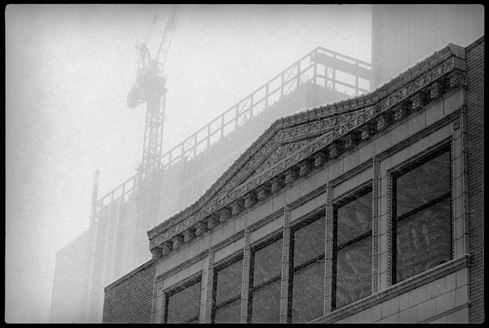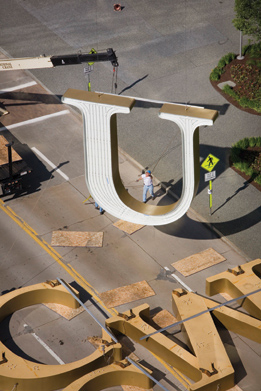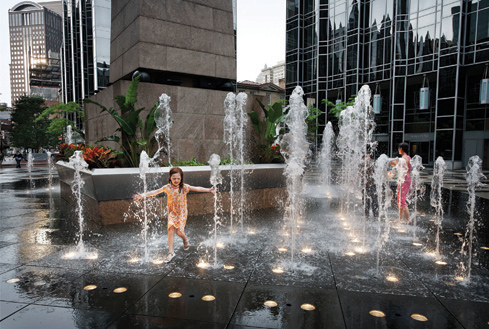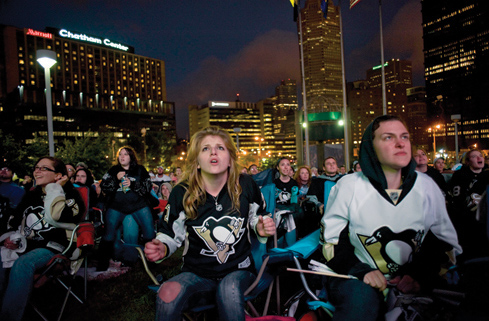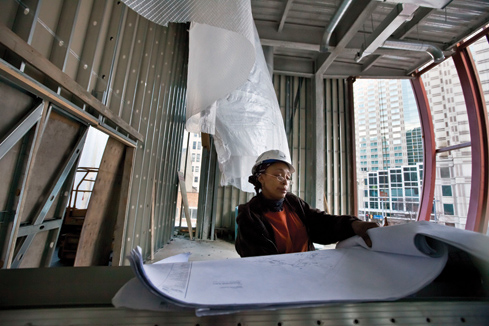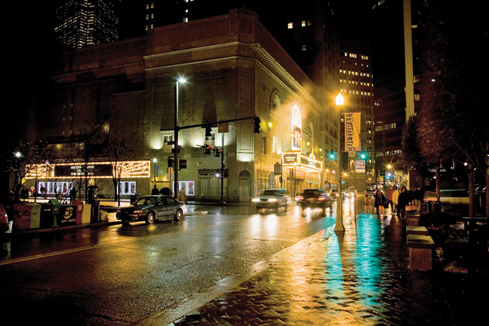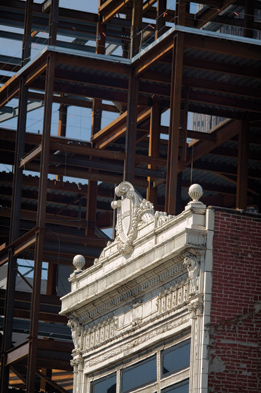 |
||||||
|
Dylan Vitone, Skateboarders, 2008, Courtesy of the artist
|
Picturing Pittsburgh
The Heinz Endowments and Carnegie Museum of Art partner to produce a photography exhibition that brings a new Pittsburgh renaissance into plain view. For 40 years, Pittsburgh photographer Mark Perrott has captured iconic images of his photogenic hometown. He’s documented everything from the dismantling of the hulking Jones & Laughlin Steel to ’80s-era hipsters arching their tattoo-covered bodies and young swimmers strutting at city pools. But Perrott recently received an assignment so open-ended and liberating that it’s made him look at the city with fresh eyes. Over three years, The Heinz Endowments set Perrott and eight other Pittsburgh-based freelance photographers loose downtown with a simple mission: Go out and explore. Shoot what you see. Capture the new construction. The result is the 411-image Downtown Now Photography Project, a successor to the Pittsburgh Photographic Library, an unforgettable collection of imagery that captured the original Pittsburgh Renaissance of the 1950s. Beginning September 23, 86 of the new images will be on view at Carnegie Museum of Art, alongside a smattering of historical photographs from the museum’s permanent collection, in the exhibition Picturing the City: Downtown Pittsburgh, 2007–2010.
Jim Judkis, Crane in Snow, 2009, Courtesy of the artist“It was really a homecoming in the sweetest way,” says Perrott. “This is a love story about Pittsburgh as a muse.” During the G-20 Summit in 2009, Perrott captured a line of monks from Myanmar (formerly Burma) as they filed past two towering policemen and into the Market Square Starbucks. Martha Rial, a Pulitzer Prize-winning photojournalist, kayaked onto the Allegheny River to capture fellow paddlers watching the fireworks after a Pirates game. In one shot, a red ball of fire fills the night sky and reflects off the water. “It reminded us of the photographs we saw of the steel industry in the ’50s,” says Linda Benedict-Jones, Carnegie Museum of Art’s curator of photography and organizer of Picturing the City. An artistic advisor for the Downtown Now project, Benedict-Jones worked alongside Mary Navarro, former senior program officer for The Heinz Endowments, to review more than 1,000 images. Annie O’Neill ventured inside a Market Square pizza shop to capture a snowy day through its windows, as handwritten signs advertising pizza slices and hot chocolate float in the foreground. Her artistic vantage point provides a cultural touchstone for future generations. “When I look at old photos, I always look at signs,” notes O’Neill. Dylan Vitone’s panoramic photograph of the 2009 Stanley Cup victory parade puts the viewer in the middle of a giddy throng of Penguins fans, their arms outstretched in triumph. And on one magical evening, Richard Kelly captured the glow of the Benedum Center reflecting off of rain-splashed Penn Avenue.
“The work in this exhibition is really interesting for us now,” Benedict-Jones says. “Fifty years from now, it will be even more fascinating for people to look back and see what this city was and how the people dressed and ‘Good heavens, they’re all using cell phones.’” The story of an American cityThe Downtown Now Photography Project and corresponding Picturing the City exhibition was inspired by the collection of roughly 18,000 images that documented, with an artistic sensibility, the first famed urban renewal of Pittsburgh. In 1950, the Allegheny Conference on Community Development, a group of powerful corporate and civic leaders, hired legendary photo editor Roy Stryker to produce a portrait of a then in-flux Pittsburgh to educate people both regionally and nationally on the benefits of comprehensive urban planning. The three-year project garnered strong support from the foundation community—the Mellon Educational and Charitable Trust, The Kaufman Foundation, and The Heinz Endowments gave annual grants—and from corporate Pittsburgh through the Allegheny Conference. “This is a love story about Pittsburgh as a muse.”
- Mark PerrottStryker convinced big-name documentary shooters such as Esther Bubley and Russell Lee to travel to Pittsburgh to capture everyday life and the city’s rapidly changing skyline. The project generated images of everything from the last steam locomotive engine in Pittsburgh to a suited downtown businessman with a shirtless construction worker balanced high above his head. The most enduring image—a narrow street in the Fineview neighborhood opening up to a glistening night skyline—is the cover of the engrossing book Witness to the Fifties: The Pittsburgh Photographic Library, 1950–1953. “There was a massive change to our city that did not go unnoticed by the national press, photographers, and artists,” notes Benedict-Jones. “It was the renaissance of the capital of the steel industry. Particularly in the 1950s, the country was very aware of what Pittsburgh had contributed to winning World War II.” Life magazine sent Margaret Bourke-White—“the Annie Leibovitz of her time,” according to Benedict-Jones—to fly over the city and shoot it from above. Stefan Lorant, another esteemed photo editor, flew in to create the book Pittsburgh: The Story of an American City. While the earlier project focused on the entire city of Pittsburgh, the Downtown Now Photography Project focuses solely on downtown—specifically to capture the more than $2 billion in new construction unfolding in that less-than-one-square-mile space over just a handful of years. Among those projects, the Consol Energy Center, the August Wilson Center for African American Culture, and the beginning of the North Shore Connector sprang up, casting new shadows and patterns of light and texture for photographers to document.
Melissa Farlow, Summertime, 2008, Courtesy of the artistThe Heinz Endowments chose the nine freelance photographers for the current project—Melissa Farlow, Jim Judkis, Richard Kelly, Kenneth Neely, Annie O’Neill, Mark Perrott, Martha Rial, Renee Rosensteel, and Dylan Vitone—for their talent and range of styles. The group met periodically. “You saw everyone else’s work,” says O’Neill. “It pushed and inspired you. It was always surprising to see everyone else’s perspective. “I told my friends in other cities that an organization was doing this simply for posterity and to see what it grows into. It was the most amazing project to participate in. The Heinz Endowments was so respectful in giving us artistic freedom, giving us feedback, no question on keeping the copyright, and giving the work a thoughtful edit.” Robert Vagt, president of The Heinz Endowments, says, “We gave the photographers ideas and hints. We did not tell them what to shoot.” What began as a way to chronicle downtown development evolved into something bigger, he adds. “It was how people were engaged in the spaces that left an impression, the biggest example being Point State Park.”
Martha Rial, Last Penguins Game at Civic Arena, 2010, Courtesy of the artistConsider a photograph by Melissa Farlow in which a man plants a tree in Point State Park, skyscrapers gleaming in the background. Carnegie Museum of Art’s exhibition will include this image, as well as a 1953 W. Eugene Smith photograph of a tree planting in Mellon Park. But Benedict-Jones won’t hang the two images next to each other, she says. “I want visitors to enjoy finding these connections on their own,” she says. An evolving perspectiveThere is no doubt that 2007 through 2010 were newsworthy years for Pittsburgh: The Steelers won the Super Bowl, the Penguins won the Stanley Cup, and the city hosted the G-20 Summit. These events provided the photographers with a wealth of unforgettable photo-ops, and each added her or his own unique perspective. The G-20 Summit was a favorite subject, and Jim Judkis chose to shoot in black-and-white, inviting particular comparison to the ’50s-era photography project. “This town is really changing. Sometimes all it takes is to tear down a building and suddenly the place is full of sunlight.”
- Martha Rial“In the ’50s, no one would think of using color film,” says Benedict-Jones. “It was barely viable. Now most of the photographers use color. Only Jim wanted to do black-and-white exclusively using conventional 4x5-inch film and a tripod. He wanted to document in a very formal way.” Also unique are Vitone’s signature panoramas. The artist digitally married a series of images but left evidence of separate exposures. “It’s his version of reality, just like all photographers have a version of reality,” adds Benedict-Jones. Some photographs simply capture signs of the times, such as Rosensteel’s image of two girls snapping a digital self-portrait. Other imagery marks the beginning of a project, such as Neely’s shot of the groundbreaking for the future August Wilson Center, or the end of an era, as Rial captured the last Penguins game at the Civic Arena by focusing on the tense faces of two young women.
Annie O’Neill, August Wilson Center Construction, 2009, Courtesy of the artistRial joined the project during its third and final year after moving back to Pittsburgh from Florida. “This town is really changing,” she says. “Sometimes all it takes is to tear down a building and suddenly the place is full of sunlight.” After shooting thousands of images, each photographer submitted a small self-selected batch of work eight times a year. Liberal selections were then made by Navarro and Benedict-Jones over the course of the project, followed by a final edit at the close of the three-year period. This generous archive was then the starting point for Benedict-Jones as she selected images for Picturing the City.
Richard Kelly, Cultural District at Night, 2008, Courtesy of the artist“It wasn’t too hard to go from 411 to 250, but then to go from 250 to 100 was painful,” Benedict-Jones says. “Going from 100 to 86 was excruciating.”
That’s why The Heinz Endowments is helping Carnegie Museum of Art sponsor an after-school program that will expose area children to both Picturing the City and the museum’s much-anticipated retrospective of the work of Charles “Teenie” Harris, Teenie Harris, Photographer: An American Story, opening this fall. During the seven-week program, students at 12 community centers will analyze exhibition photographs, study lighting and point of view, take portraits, and make collages. Some of the Picturing the City photographers will talk to the students about their craft. Then, in March, the museum will host an exhibition of the children’s work. “When these kids learn about photography and how it can express one’s idea,” says Marilyn Russell, the museum’s curator of education, “they learn about Pittsburgh history, and then think about themselves as the people who will write the next chapter of the city’s future.”
|
|||||
In Praise of the Superhero · For the Birds … and the Environment · The STEM solution · Directors' Note · NewsWorthy · Face Time: Kristoffer Smith · Science & Nature: Big on Brains · Artistic License: Architectural Wonder · First Person: Summer Dreaming · The Big Picture
 |
Copyright © 2017 CARNEGIE Magazine. All rights reserved. |

